Compared to producing high-quality content for your channel, coming up with YouTube video titles may not seem like that tough of a task. But to make sure your videos stand out from the rest, you need to take these 100 characters seriously.
To help you excel at this task, we’re sharing:
- Why YouTube titles matter
- 5 tips for writing stand-out YouTube titles
- YouTube titles to inspire you (+why they work)
Let’s jump in!
Why YouTube titles matter
YouTube titles are, more often than not, the first thing viewers see. Just like the headline of an article or a book’s cover, they help people assess at a glance what content to expect and whether or not it’s relevant or interesting.
They’re crucial in capturing the attention of potential viewers, as well as driving clicks and views. Additionally, YouTube video titles—and the keywords within them—are a major part of how the YouTube algorithm properly categorizes and promotes your videos.
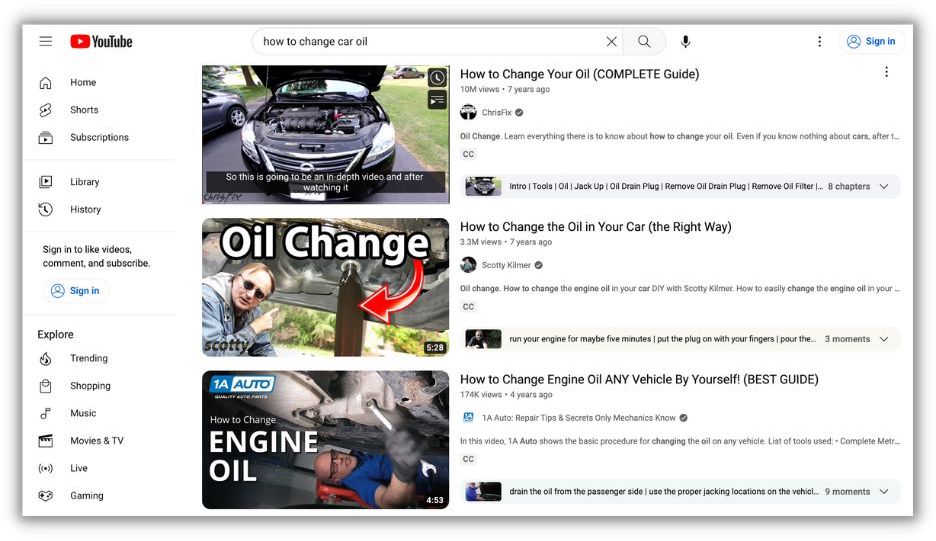
The content of your videos, of course, has to be top-notch for viewers to keep watching, and even bookmark, comment on, or share them. But there’s no denying that nailing your title is key to gaining more online visibility and driving engagement.
And there’s no better way to learn to write optimized, click-worthy titles than to analyze the types of titles that others have seen success with, which is why we’re sharing some of our favorite YouTube titles a little later.
5 tips for crafting enticing YouTube titles
But first, let’s cover a handful of best practices for how to write YouTube titles that get your videos discovered and viewed.
1. Be mindful of character limits
YouTube’s character limit for titles is 100. However, because titles are typically truncated or cut short on mobile devices, it’s best to keep titles to around 60 or 70 characters. That’s not much so being concise is critical. Every word has to count.
2. Use relevant keywords
With over 2.5 billion monthly active users, YouTube is the destination for video content. So, naturally, you want your videos at the top of its search results when potential viewers look for relevant queries. And as recommendations for viewers who watch content similar to yours.
This means you need to use the keywords you want to rank for in your video titles. Not only can it help YouTube to understand what your videos are about and rank them accordingly, but it can help your videos show up in Google search results as well.

And, even besides the SEO benefits, adding target keywords to your titles creates a direct connection between what viewers are searching for and your videos. It sets expectations about what they can expect from your content. This makes people more likely to click on and watch your video. (Both will help get you seen by even larger audiences.)
You need to do keyword research for other types of SEO content like blog posts. The same is true for YouTube videos. You’ll need to find out what terms your audience is using so that you can optimize for them.
3. Make it eye-catching
While including relevant keywords is important, titles shouldn’t be drab and keyword-stuffed. You need to, first, grab attention and, second, give potential viewers a reason to click on your video. So, strategically use:
- Numbers to create curiosity or set expectations for what viewers will get out of your videos.
- Questions to get people mentally engaged and interested in your thoughts on a topic.
- Parentheticals for emphasis and to heighten curiosity about your content.
- Humor or alliteration to help your videos stand out from everyone else’s.
- Words in all caps to grab attention or emphasize a point.
Of course, not all of the above will be right for every title. But, each time you’re brainstorming YouTube titles, think about which of the above elements could make them more captivating.
You might also consider including your title as part of your YouTube thumbnail, which can help capture attention in search results.
4. Test out different titles
Experimentation and practice are a big part of learning to craft a good title for your video content. But there’s more to it than just trying different things.
Reflect on what types of YouTube titles drive more clicks, longer watch time, and more engagement from your target audience. Learn from those observations so you can draw in even more viewers in the future.
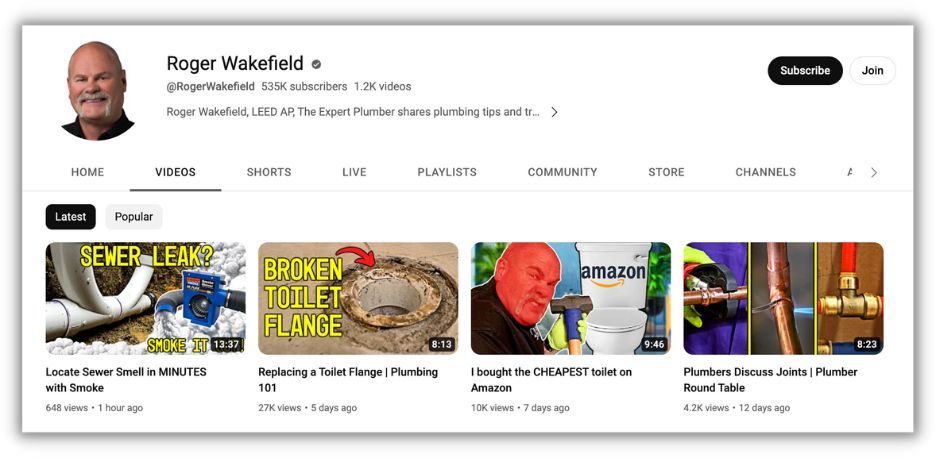
You can see this plumber uses different types of titles for his YouTube videos.
5. Avoid clickbait titles
Clickbait titles are either extremely vague or make exaggerated claims and promise things that the content doesn’t deliver. They’re essentially false advertisements, as what viewers expect to see in your videos is not what they get. This can lead to disappointment, frustration and, ultimately, give your content a bad reputation.
Although clickbait titles can be effective in drawing viewers, you don’t want this kind of negative attention for your channel.
While you can use language to spark mystery and curiosity or to generate excitement, you can’t set inaccurate expectations.
9 YouTube video titles to inspire you (+why they work)
It’s not always enough to have best practices and tips. Sometimes it’s easier when you see them in action. So here are some titles from real YouTube videos, along with the lessons you can learn from each of them.
Example #1: WordStream
This video from WordStream has amassed over 12,000 views, and the video title likely has a lot to do with it.
Ads not showing? Don’t panic! 11 reasons your Google ads aren’t showing | WordStream
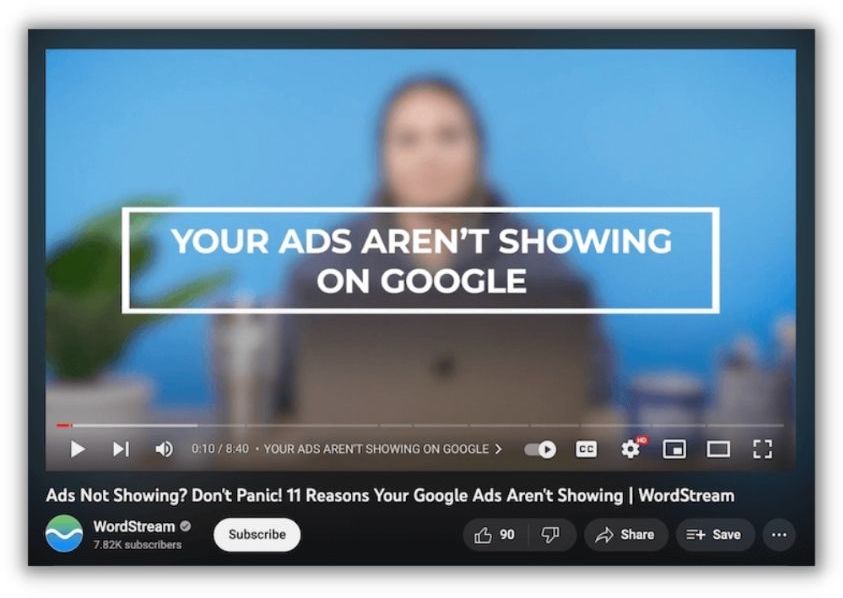
Why does this title work?
- Starts with a pain point the intended audience has (i.e. their ads not showing).
- Uses a question to get the potential viewer to mentally engage, acknowledge this pain point, and immediately recognize the video as relevant to them.
- Acknowledges a strong emotion that’s commonly associated with the pain point, while also hinting that there’s a solution to the problem.
- Promises a comprehensive explanation of potential causes of the problem mentioned with specific on the number of reasons discussed.
If you think about it, this title uses the famous Pain Agitate Solution (PAS) copywriting framework. It highlights a challenge the target audience faces, reiterates that challenge, and then promises a fix.
Example #2: Bigger Pockets
Next, is an example from Bigger Pockets—a popular channel with a focus on real estate investing. This video has racked up one million views and over 30,000 likes.
Real estate investing rules you MUST know (The 2%, 50% & 70% rules)
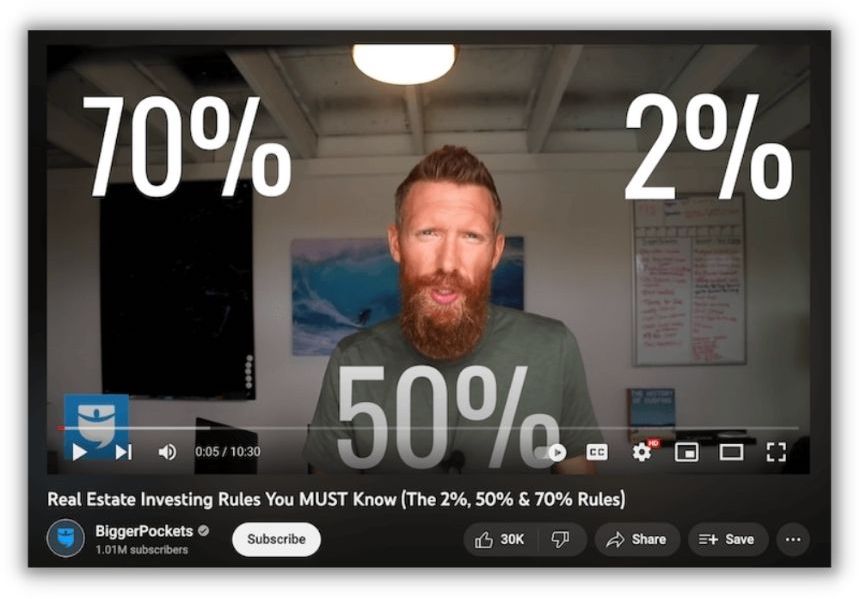
Why does this title work?
- States clearly what the video is about.
- Uses caps (sparingly) to make a point and highlight that viewers can’t afford to go without the information provided in the video.
- Gives additional context on what viewers can expect to spark interest and build trust.
Plus, the title includes the keyword Bigger Pockets wanted to show up for in YouTube search results. Type “real estate investing rules” into the search bar and this video appears second.
Example #3: Chevy Dude
This title is on the longer side, clocking in at just under the 100-character limit. However, the way it’s written is part of the reason this video has been so successful with nearly 6 million views.
9 fees to NEVER pay a car dealership. Tips on car buying, how to negotiate, and how to buy a car.
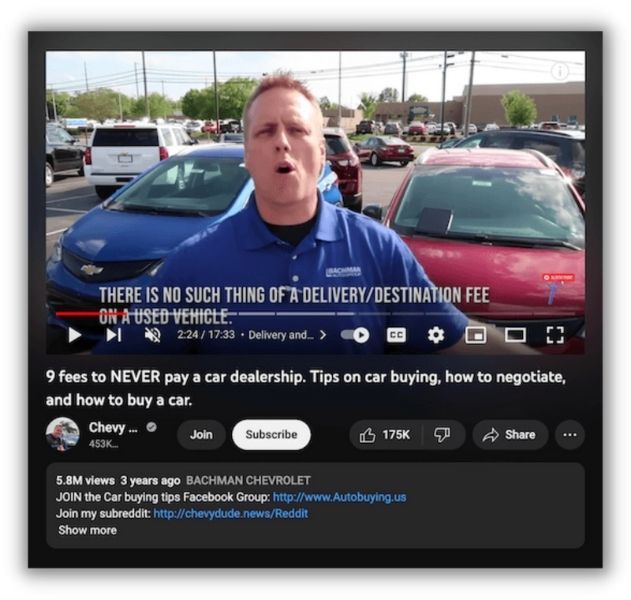
Why does this title work?
- Quantifies the value viewers can expect from the video with a number (and sparks their curiosity about their lack of knowledge on the subject).
- Uses caps on “never” for emphasis and implies that potential viewers can’t afford to scroll past this video.
- States some topics covered in the video.
You can use a similar combination of numbers, emphasis on the audience’s knowledge gaps, and context on topics covered.
Example #4: Lurie Children’s Hospital
This video is the second most popular on Lurie Children’s Hospital’s YouTube channel. With over 825,000 views and 7,100 likes, it goes to show that you don’t necessarily need a flashy title to drive clicks.
Sensory Processing Disorder: Occupational Therapy Demonstration

Why does this title work?
- Sets clear expectations about the topic in a few words.
- Uses a tone and style appropriate for the topic.
- Uses two relevant keywords, which increase the chances of this video showing up in search results for sensory processing disorder and occupational therapy.
The lesson? Creative, conversational titles (like many of the ones we’ve seen) can work. Yet, simplicity can be effective too.
Example #5: Robert Allen
This next YouTube title example comes from Robert Allen—a direct response copywriter who has generated more than $100 million in sales. While this isn’t Rob’s most popular video, it has done pretty well and provides a good model you can follow.
Here’s a $35,000 email funnel idea you should steal…

Why does this title work?
- Quantifies the value of the idea, implying both that it has already made $35,000 and that it could be worth that for viewers.
- Alludes to the idea that the info is so high value it shouldn’t be given away for free and is worth being “stolen.”
- Encourages potential viewers to take action using the phrasing “you should steal.”
The lessons here? Emphasize the value of what your video has to offer (and put a number on it if possible). Use marketing trigger words strategically to motivate viewers to click. And use active language to nudge them toward doing so.
Example #6: Recruiter Preston
Preston Park, whose videos routinely get upwards of 10,000 views, often uses this YouTube title type. In fact, it’s the most commonly used type across the videos on the Recruiter Preston channel.
Best Sourcing Strategies to find the best Sourcing CANDIDATES! Explained by Recruiter
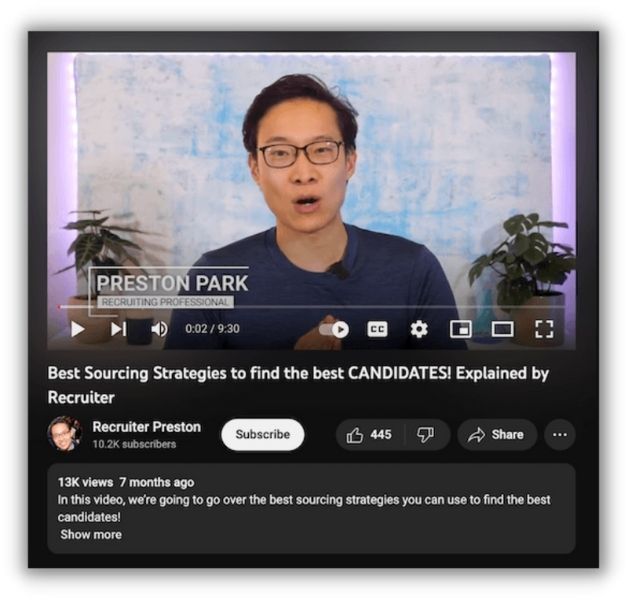
Why does this title work?
- Uses the trigger word “best” (twice) to indicate that the video content is high value.
- Uses and frontloads the keyword “best sourcing strategies,” which also enables it to rank within the top three results for the keyword “sourcing strategies.”
- Builds credibility and trust by highlighting that the creator of the video has firsthand experience doing what’s being taught.
Clearly, this approach works since Preston uses it often. You can use it effectively as well. Introduce your topic, preferably using a keyword, set an expectation as to the quality of the information, and give a reason viewers can trust you.
Example #7: Lonestar Hawaiian
This video from Lonestar Hawaiian has racked up over 2 million views and 20,000 likes. The video content resolves an urgent problem for its audience, and the video title does a good job of making that clear.
Car Won’t Start: Alternator or Battery? The easy way to know

Why does this title work?
- Uses the high-volume keyword “car won’t start,” which also happens to be a pain point for the audience.
- Offers two possibilities, which makes potential viewers feel closer to having a solution than a vague title like “Car Won’t Start: How to Find Out What’s Wrong.”
- Mentions that there’s an easy way to find out the issue, which can put viewers that aren’t car-savvy at ease.
The formula here is to state the topic and allude to light at the end of the tunnel.
Example #8: Top Notch Lawn Care
We all know that too many words in all caps can make people feel like they’re being yelled at. But this YouTube video from Top Notch Lawn Care, which has been viewed over 11 million times, shows how caps can be used effectively.
SHOCKING Backyard TRANSFORMATION for Elderly Woman – SATISFYING RESULT
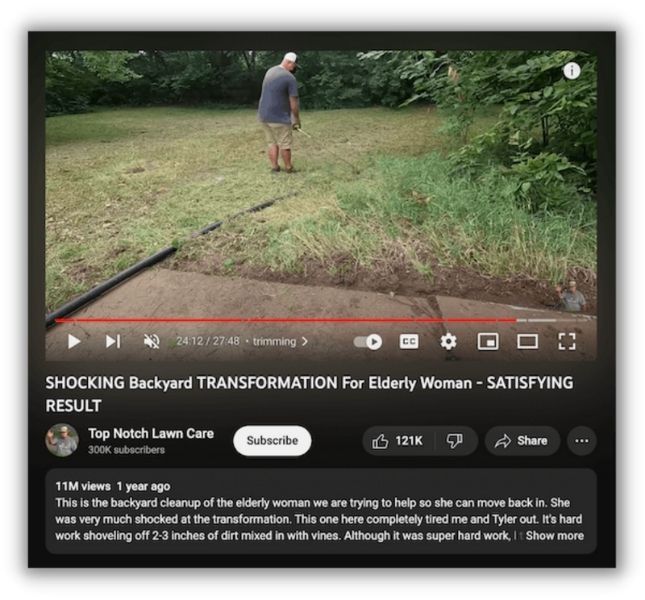
Why does this title work?
- Strategically capitalizes key words so that, at a glance, “Shocking transformation; satisfying result” piques curiosity.
- Uses strong words such as “shocking” and pulls on heartstrings with the mention of the elderly woman.
- Teases the outcome to heighten viewers’ desire to see it.
This approach works great for case study-type video content. Not only is it eye-catching but, if your video content delivers, it builds viewers’ trust in your ability to help them too.
Example 9: Everyone Hates Marketers
Next is a video from the Everyone Hates Marketers YouTube channel. This video, which has been viewed over 308,000 times and liked over 8,000 times, is a good example of the power of namedropping.
Seth Godin’s Marketing Secrets to Launching a New Business

Why does this title work?
- Clearly states the topic and what people will be able to do with the information shared in the video.
- Names a respected industry authority to drive clicks and emphasize the credibility of the content.
- Piques curiosity by implying that viewers will get access to insider knowledge.
This YouTube title style is great for interview-based videos with well-known industry figures. But namedropping can also work with names people might not necessarily know at a glance.
For example, a healthcare practice might title one of their videos, “3 Keys to Better Sleep With Dr. Jeff Johnson, MD.” In this case, it’s the credentials that build viewers’ confidence in the quality of the information and can encourage clicks.
Time for a YouTube video titling challenge
Crafting the perfect YouTube title is an art form. As you can see from the many approaches in the examples above, there’s no single formula for creating great ones. That said, it’s worth testing various types and analyzing which ones perform better.
Not sure where to start? If you’re already posting to your YouTube channel, there are a couple of things you can do:
- Identify your top-performing videos via YouTube analytics. Use similar title types for your upcoming videos and see how performance compares.
- Identify your worst-performing videos. Using what you’ve learned here, adjust the video titles and see if performance improves within a set period of time (e.g. two weeks).
And if you’re not yet posting content to your YouTube channel? Pick the title type you think would work best for your audience from the examples we looked at. Adapt it for your business, see how it goes, adjust as needed, and repeat.
Soon enough, you’ll have a better idea of which titles get you the most visibility in search results and which ones your audience thinks are the most click-worthy!
Related Articles
-

9 Tips for Better Video Rankings (& More Views!)
-

20 YouTube Shorts Ideas That'll Get You More Views & Subscribers (+Examples)
-

14 Click-Worthy YouTube Thumbnail Examples (+How to Create Your Own)
-

How to Make & Upload YouTube Shorts in a Snap
-

Starter Guide to YouTube Advertising Costs in 2024 (+5 Ways to Spend Less)

